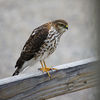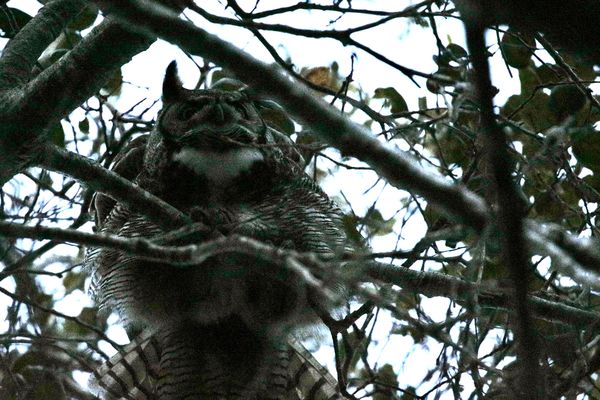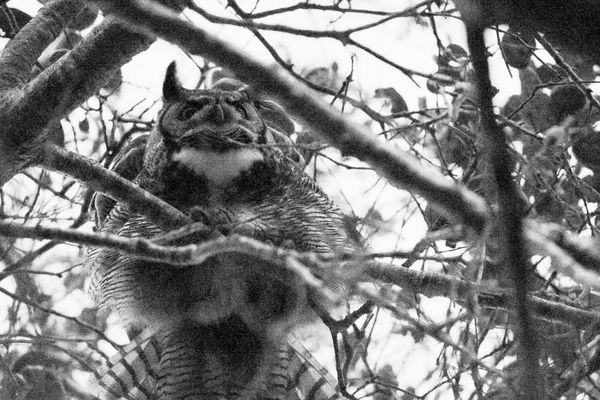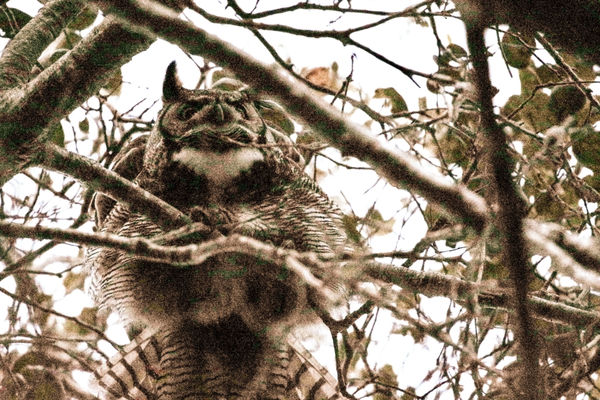How to fix dark pictures
Feb 14, 2021 23:15:57 #
To Gabyto. I shoot a 5D III with a 100-400 II L and I use a 12’ cable release found on The internet. This allows for a somewhat remote setup. Good luck, hope this helps.
WJH
WJH
Feb 15, 2021 01:11:22 #
I think before you owl hunting again, you should learn how the camera's light meter works and how to read a histogram.
https://www.google.com/search?client=firefox-b-1-d&q=how+to+read+a+histogram
https://www.google.com/search?client=firefox-b-1-d&q=how+to+read+a+histogram
Feb 15, 2021 08:24:07 #
rdubreuil
Loc: Dummer, NH USA
In these conditions in my opinion, remove the teleconverter, you’re loosing one stop of light right off the bat. Open your lens as wide as it will go, bump the ISO up and as slow a shutter speed as you can while still avoiding motion blur. Here’s one shot at dusk, much darker than that and you will need to add light to the mix. Keep trying and you’ll eventually get the shot, good luck and keep shooting.
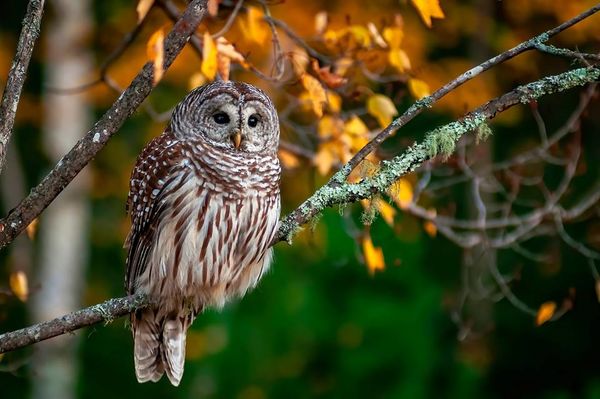
Feb 15, 2021 09:42:57 #
The Watcher wrote:
I think before you owl hunting again, you should learn how the camera's light meter works and how to read a histogram.
https://www.google.com/search?client=firefox-b-1-d&q=how+to+read+a+histogram
https://www.google.com/search?client=firefox-b-1-d&q=how+to+read+a+histogram
You are right my skills about it need to improve. What else would you recommend to improve my pictures at night?. I would really appreciate it. Thank you
Feb 15, 2021 12:02:19 #
hj
Loc: Florida
Gabyto wrote:
Hello UHH members,
I can not seem to get a better picture of this owl at night. I increase the exposure to the max, but It did not work. My gera is Canon 5Div, Canon lens 100-400ii+1.4 extender III. Any help will be greatly appreciate. Thank you
Gabyto
I can not seem to get a better picture of this owl at night. I increase the exposure to the max, but It did not work. My gera is Canon 5Div, Canon lens 100-400ii+1.4 extender III. Any help will be greatly appreciate. Thank you
Gabyto
Though there is a lot of noise, I got these results in about 15 seconds from Apple's "Photo" app that comes with the mac computers. Not good but much better than the OP posted.
Feb 15, 2021 12:27:17 #
hj wrote:
Though there is a lot of noise, I got these results in about 15 seconds from Apple's "Photo" app that comes with the mac computers. Not good but much better than the OP posted.
Very nice...Apple always improving their software.
Feb 15, 2021 14:22:17 #
amfoto1
Loc: San Jose, Calif. USA
Sometimes when forced to use ultra high ISOs it can help to convert an image to black & white. See below how your images looks in B&W. I also applied some heavy noise reduction and a lot of adjustment to brighten it up in Photoshop. The noise in the image is made even worse because it's so under-exposed. When the image brightness is boosted, the noise shows up in spades.
Once an image is converted to B&W, it's possible to "colorize" it. I haven't tried this myself, but have seen some videos online about doing it. The results can be pretty neat.
In this case, you really shot yourself in the foot because you were using far faster shutter speed than necessary: 1/1000. The image EXIF says you were using manual exposure, but maybe you were using Auto ISO?
I know you had a 1.4X on the lens, so were effectively getting a 560mm f/8 with the lens aperture wide open. With that 100-400 II's image stabilization, you probably could have gotten a sharp shot at 1/125 handheld... three stops slower... so could have used ISO 6400 (instead of 12800) AND brightened up the image by two full stops! With a stationary subject you might even have been able to use 1/60 or 1/30, especially if you had a monopod. If that were possible, you might have been able to use even lower ISO... 3200 or 1600. These settings would have given much brighter image with less noise.
Whenever shooting something challenging like this, I check the image histogram, adjust and re-shoot when necessary. In this case, the massive under-exposure was obvious with a glance at the histogram, even without seeing the image.
Someone suggested using spot metering and that may have helped if you were using some form of auto exposure. The bright sky behind the bird would cause a camera's meter to read high and want to render an under-exposed image in any auto exposure mode (including manual with auto ISO, which is actually just another auto exposure mode). Even if setting fully manually, but relying upon the camera's meter, it would have given you too high settings. You have to recognize those and adjust manual exposures accordingly.... or dial in some exposure compensation when using any of the auto exposure modes.
When I see an interesting subject, I don't just take one shot and call it done. In fact, when lighting is challenging like this case, that first shot... and maybe a couple more... might just be to help me figure out the exposure. I don't trust the image playback.... but histograms never lie. Once I get an exposure set, I may take 3 or 5 or dozens from different distances and angles. In fact, I might set up the camera to bracket exposure and set the camera to take high speed bursts.
Even if you could use it, flash wouldn't have worked for this shot anyway. The branches between you and the bird would have thrown a shadow across the owl. I don't know about owls and flash, specifically. Most animals ignore a flash used from a reasonable distance, especially a weaker "fill" flash. Animals are accustomed to similar, natural flashes of light... lightning storms, the sun glinting off water and other surfaces, etc. Flash also doesn't work for bursts of shots like I suggested above. You have to wait for the flash to recharge between shots (sometimes with a weaker fill flash it's possible to get two or three shots in a row... depends upon the flash).
Besides making a better exposure in the camera itself, another thing you might have tried is luring the bird out of its hiding place. A predator call might have gotten its attention and caused it to come out to look around. There are various calls available, but sounds of a mouse or rabbit or other small critter that's typical owl prey might have brought the bird out for a better photograph. In addition to some traditional hunting calls, I have an app on my phone with a bunch of different sounds. Of course, the speaker in my phone isn't very good, but owls have great hearing and their prey aren't very loud critters either.
Again, below is a B&W conversion of your image. There's still a lot of noise, but somehow it always looks better in B&W.
Once an image is converted to B&W, it's possible to "colorize" it. I haven't tried this myself, but have seen some videos online about doing it. The results can be pretty neat.
In this case, you really shot yourself in the foot because you were using far faster shutter speed than necessary: 1/1000. The image EXIF says you were using manual exposure, but maybe you were using Auto ISO?
I know you had a 1.4X on the lens, so were effectively getting a 560mm f/8 with the lens aperture wide open. With that 100-400 II's image stabilization, you probably could have gotten a sharp shot at 1/125 handheld... three stops slower... so could have used ISO 6400 (instead of 12800) AND brightened up the image by two full stops! With a stationary subject you might even have been able to use 1/60 or 1/30, especially if you had a monopod. If that were possible, you might have been able to use even lower ISO... 3200 or 1600. These settings would have given much brighter image with less noise.
Whenever shooting something challenging like this, I check the image histogram, adjust and re-shoot when necessary. In this case, the massive under-exposure was obvious with a glance at the histogram, even without seeing the image.
Someone suggested using spot metering and that may have helped if you were using some form of auto exposure. The bright sky behind the bird would cause a camera's meter to read high and want to render an under-exposed image in any auto exposure mode (including manual with auto ISO, which is actually just another auto exposure mode). Even if setting fully manually, but relying upon the camera's meter, it would have given you too high settings. You have to recognize those and adjust manual exposures accordingly.... or dial in some exposure compensation when using any of the auto exposure modes.
When I see an interesting subject, I don't just take one shot and call it done. In fact, when lighting is challenging like this case, that first shot... and maybe a couple more... might just be to help me figure out the exposure. I don't trust the image playback.... but histograms never lie. Once I get an exposure set, I may take 3 or 5 or dozens from different distances and angles. In fact, I might set up the camera to bracket exposure and set the camera to take high speed bursts.
Even if you could use it, flash wouldn't have worked for this shot anyway. The branches between you and the bird would have thrown a shadow across the owl. I don't know about owls and flash, specifically. Most animals ignore a flash used from a reasonable distance, especially a weaker "fill" flash. Animals are accustomed to similar, natural flashes of light... lightning storms, the sun glinting off water and other surfaces, etc. Flash also doesn't work for bursts of shots like I suggested above. You have to wait for the flash to recharge between shots (sometimes with a weaker fill flash it's possible to get two or three shots in a row... depends upon the flash).
Besides making a better exposure in the camera itself, another thing you might have tried is luring the bird out of its hiding place. A predator call might have gotten its attention and caused it to come out to look around. There are various calls available, but sounds of a mouse or rabbit or other small critter that's typical owl prey might have brought the bird out for a better photograph. In addition to some traditional hunting calls, I have an app on my phone with a bunch of different sounds. Of course, the speaker in my phone isn't very good, but owls have great hearing and their prey aren't very loud critters either.
Again, below is a B&W conversion of your image. There's still a lot of noise, but somehow it always looks better in B&W.
Feb 15, 2021 15:14:23 #
amfoto1 wrote:
Sometimes when forced to use ultra high ISOs it ca... (show quote)
Thank you for taking the time to teach me all this new information. I will definitely look for the app for animal sounds. I really was not looking for the owl. I just got lucky to find it. Again thank you
Feb 15, 2021 17:24:09 #
amfoto1
Loc: San Jose, Calif. USA
Gabyto wrote:
...I really was not looking for the owl. I just got lucky to find it....
If you went looking for an owl, you probably wouldn't find one! That's the nature of owls.... and birds of prey or even wildlife in general.
I was doing some scenic shots at the coast when I noticed a red tail hawk hunting in the area. It was so busy looking for lunch it ignored me and all the other people in the area. I had the "wrong" camera and even ended up with the wrong settings, but still gave it a try and got some usable images. Fortunately it was a very patient and cooperative bird that was circling a field and repeatedly using several perches for over half an hour.
The perched shots weren't great. It was shaded and the tangle of branches in the background was too busy:

The neighbors really didn't appreciate a hungry hawk in the area, but that fast action was hard to catch with the camera I had been using to take shots of surf and lighthouses:

The hawk even "pounced" on something very near me once. I just wish his face hadn't been shaded.:

Still, for a half hour or more I kept watching the bird and "trying things", hoping to get a shot I was happy with. I finally got a nice pose I was able to print 16x20":

Now, normally I wouldn't have used the 1/8000 shutter speed for the above image. But I'd been trying to get a shot in the shade (maybe the tree perch above) and didn't have time to change my camera settings when the hawk suddenly decided to swoop close by.
By the way, do you know how to tell when a bird is just about to take off from a perch? Often they take a poop right before they launch! "Lightening the load", I guess.

That hawk was still hunting when I went back to my scenic shots:

Wildlife photos are rarely planned, though this young lady was a daily visitor in my "back yard" for a few months and soon got relaxed with me around, giving me lots of opportunities to make "portraits" of her:

I've also found various places nearby where I'm almost guaranteed to see some wildlife and can be sure to bring the right camera and lenses!




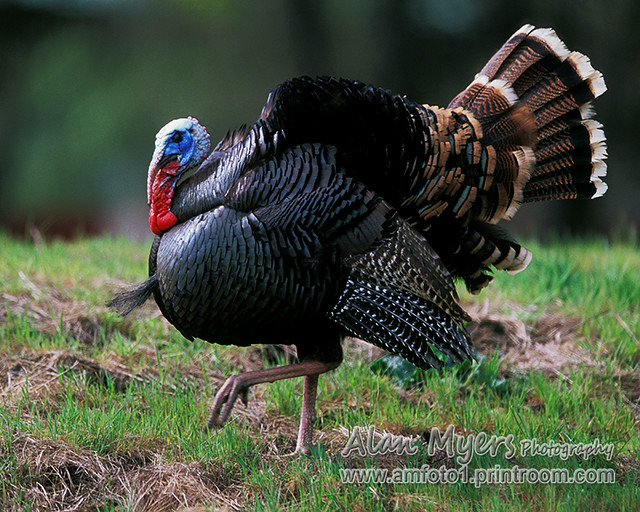
Feb 15, 2021 20:52:31 #
amfoto1 wrote:
If you went looking for an owl, you probably would... (show quote)
You are living on paradise ✨. I am not that lucky, but I looked for the wild life any chance I get. I really appreciate the tips and advice given. Are you in the East Coast?.
Feb 20, 2021 14:05:32 #
Gabyto wrote:
As others have said, you need more light (wider aperture and/or lower shutter speed and/or higher iso). Here's 5 minutes of post processing with Photoshop raw filter and gaussian blur filter.Hello UHH members,
I can not seem to get a better picture of this owl at night. I increase the exposure to the max, but It did not work. My gera is Canon 5Div, Canon lens 100-400ii+1.4 extender III. Any help will be greatly appreciate. Thank you
Gabyto
I can not seem to get a better picture of this owl at night. I increase the exposure to the max, but It did not work. My gera is Canon 5Div, Canon lens 100-400ii+1.4 extender III. Any help will be greatly appreciate. Thank you
Gabyto
Feb 20, 2021 14:14:36 #
Bobspez wrote:
As others have said, you need more light (wider aperture and/or lower shutter speed and/or higher iso). Here's 5 minutes of post processing with Photoshop raw filter and gaussian blur filter.
Very nice , I guess photo shop is the best software from all the others.
Feb 20, 2021 14:21:31 #
Gabyto wrote:
Thanks. I've used Photoshop for years, so it's become second nature. I pretty much know what will give me the adjustment I want quickly. I don't use layers, just various adjustment and filter sliders.Very nice , I guess photo shop is the best software from all the others.
Feb 20, 2021 14:39:02 #
hj
Loc: Florida
Gabyto wrote:
Very nice , I guess photo shop is the best software from all the others.
And several times more expensive from the others..... and possibly a greater learning curve than many others.
Feb 20, 2021 16:27:32 #
Gabyto wrote:
I really don't think the park Ranger will like me to disturb the wildlife. Also owls and the use of a flash do not go together.
Amen and Amen!
If you want to reply, then register here. Registration is free and your account is created instantly, so you can post right away.
